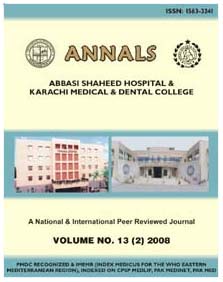
| |
| Home |
| Editorial Staff |
| Instruction to Authors |
| Journal-Issues |
| Policy |
| Copyright |
| CLINICAL SPECTRUM OF SPINAL MUSCULAR ATROPHY
ZAHOOR AHMED, SALEEM ILYAS, MUHAMMAD ABDULLAH ABSTRACT Objective: To evaluate the clinical pattern, frequency of occurrence and diagnostic approach to spinal muscular atrophy (SMA). Method and Subjects: It was a descriptive study comprising 30 patients of different ages and both sexes having lower motor neuron signs compatible with different varieties of SMA, with electrophysiological evidence of anterior horn cell disease, and absence of sensory symptoms and upper motor neuron signs. Results: Different varieties were screened during this study. Though most of the varieties were found, not all varieties were captured during the study period. SMA type III was the most common variety. Overall male to female ratio was 4:1. Family history was positive in only a quarter of cases. Limb weakness and wasting were the most common symptoms with more frequent proximal weakness than distal; and generalized weakness was the least common. Best diagnostic tool was electromyography (EMG) as apposed to muscle biopsy which can be reserved for cases with uncertain diagnosis. CPK was a highly non specific marker but helped to differentiate SMA from primary muscle disease at times. Conclusion: Many varieties of SMA are prevalent in our region and can be diagnosed with conventional techniques, EMG being the most sensitive and less invasive tool in the absence of molecular genetic testing.
|
For Full text contact to: |
